Recently, much attention manufacturers of laptops on so-called subnotebook - a device that combines convenience and broad functionality of a notebook with one hand and the relatively small size and weight, inherent PDAs - on the other. Overview of the most popular models. Long ago, in the reign of the legendary "dvushek" engineers of Japanese firm Toshiba released the first portable computer such as laptop, freak by today's standards, weighing 7-10 kg, and feeds only on the network. But then it was a breakthrough - the first mobile PC that you can take with you wherever you go - fantastic! As time passed, there were laptops, according to the present mobile computers that are having a weight of 2 to 4 kg and a battery-powered, could ensure the implementation of the vast majority of functions of a modern desktop PC. But for routine use in road conditions, even these machines were too heavy. Therefore, recently much attention to manufacturers of laptops on so-called subnotebook - devices that have weight less than 3.5 pounds (about 1.6 kg) and a thickness of 2 to 3 cm length and width of the mobile computer are determined mainly by the size of keyboard and display, according to these parameters subnotebooks do not differ from conventional laptops. While on their weight and size characteristics between classical laptops and keyboard handhelds (PDAs), subnotebooks are a compromise solution that combines ease of use and rich functionality notebook with one hand and the relatively small size and weight, inherent PDAs - on the other. But, like any compromise, the sub-notebooks have their drawbacks. Perhaps the most significant of these is the application in order to reduce weight and dimensions, especially thickness, rather inconvenient to use external hard drives. And the small size batteries provide less operating time, therefore, in order to maintain an acceptable operating time, developers have deliberately limit the ability of sub-notebooks, although in recent years, with the advent of the latest processors and other components with much less than before, power consumption, this problem gradually fades into the background.
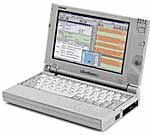 |
Opening the era of mobile computing, Toshiba, and then not released from his hands palm, proposing in 1997 a very successful, for its time, a series of subnotebooks Libretto. In this series the processor type Pentium, ranging from 75 MHz in the low-end model 50ST, and ending with the MMX Pentium 166/233, in the most popular models of Libretto 100/110ST successfully and survived until today. Being almost full-fledged computer, equipped with a hard drive that automatically allows you to use the OS Windows 9x, full-color TFT display, which supports working resolution of 800 x 480 resolution and 32 megabytes of expandable memory, Libretto still able to perform most tasks, which focus on larger notebooks. To manipulate objects on the screen using a mini-joystick-type AccuPoint, located on the lid of a subnotebook, the right of the screen. Sound system includes 16bit stereo sound card, performed on Yamaha OPL3 chip and is compatible with SoundBlaster Pro, built-in mono microphone and speaker. To communicate with the outside worlds, but built-in IR port, bundled with a port replicator port: serial RS 232, VGA, parallel (ECP) and PS / 2 for external mouse and keyboard.
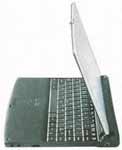 |
Logical continuation and development Libretto Series was a series Portege 3hhh. In this series, the firm Toshiba, a modest increase in size and weight of sub-notebooks, has received powerful systems, capable to compete with the latest models of full-size notebooks.To date, the production model are 3440ST and 3480ST, differing only only applicable processor (Pentium III 500 and 600, respectively, while the latter supports SpeedStep - proprietary technology of energy saving Intel) and HDD. The standard configuration Portege, as Libretto, comes only with an external floppy drive, and for those wishing to use the CD-ROM, you must purchase an external model with the connection through port PC-card. Manipulator AccuPoint, as in all the 'big' laptops Toshiba, located on 86-key, almost full-sized keyboard. Removable lithium battery provides continuous operation time of up to 3 hours, but there is an optional high-capacity battery, and with it this time increases already up to 8,5 hours.
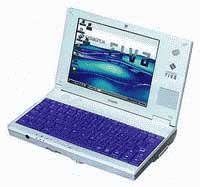 |
Using design solutions applied in the Libretto, a Japanese corporation Cassio has launched a family of very cute netbooks under the general title FIVA. To date, there are two versions: MRS101 and MRS102 using integrated CPU / video processor National Semiconductor Geode (Media GX) 200/233 MHz, HDD capacity of 3,2 / 6 MB of RAM and a standard capacity 32/64 MB, respectively. Both models use high-quality 6.7-inch SVGA display, technology Hyper Amorphous Silicon TFT (HAST). MRS102 model, moreover, may either have a built-in V.90 modem (M63E) or not (M62E). The audio subsystem consists of a sound card compatible with Sound Blaster 16, built-in mono microphone and speaker, and output jacks for headphones and line (stereo), similar to solutions used in subnotebooks most other firms. For communication with the modern equipment, including desktop computers, there are USB ports and infrared, and for the legacy (COM, LPT, PS / 2) - have to use Port Replicator. Actively developing udavshuyusya model, the company Cassio plans to launch yet another modification of the FIVA on the basis of modern vysokoekonomichnogo processor Crusoe - FIVA MPC-206. Being a truly hi-end solution for devices such small sizes, the new model is equipped with integrated IEEE-1394, 100Base-TX Ethernet, modem, slot for CompactFlash and PC Card. Well, such "goodies" like 8.4''color LCD screen, 128 MB RAM and 20 GB hard drive just set off and so have a clear picture. But the main highlight of yet not in this - the laptop has two operating systems, Windows Me and Linux, and switch between them with the switch mounted on the sidewall!
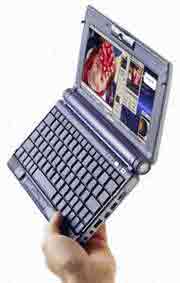 |
Most small notebooks manufactured by Sony, includes a line of VAIO PictureBook C1 XX, and differ from all other subnotebooks presence of built-in video camera that works, in addition to videos, also in photo. It uses a 1/6-inch CCD-matrix (350 thousand pixels) that creates the image size is 640 x 480 resolution. Today, this line includes several outdated and already finished its production cycle model VAIO PictureBook C1 XS, built on the good old processor Intel Pentium II 400 MHz, and replaced its VAIO PictureBook C1 VN, which uses the latest "squeak" computer mode - pretty sensational in the last year processor company Transmeta Crusoe TM5600, clocked at 600 MHz in the normal and 300 MHz - in economy mode. But this is a gem of this series, I think still not built and, frankly, do not quite understand why you would need a video camera, and no exotic processor, showing the way, very modest results in comparison with their competitors from Intel, and a spectacular LCD monitor.Display (aspect ratio of 2.13: 1, image size 1024 x 480 pixels, 8.9 inches diagonal) affects picture quality - even small fonts are perfectly readable, and the moving image is not noticeable inhibition, typical for most LCD panels. Sony has with enviable persistence uses its new developments in all their products by promoting them as candidates for future industry standards. Thus, in PictureBook C1 VN is the Memory Stick slot for proprietary flash-memory cards used in the most recent models of technology Sony - from the recorders to video cameras, and gaining acceptance, and other manufacturers of computer equipment. Another innovation - the wheel Jog Dial, using which, it is very easy to control the cursor - to scroll through menu items, it is enough to rotate the Jog Dial, and to make a choice, just need to press it. All subnotebooks from Sony, unlike other manufacturers, are equipped with stereo speakers, which only emphasizes once again the most powerful multimedia focus, but rather expensive sub-notebooks Sony.
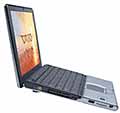 |
His second series of sub-notebooks, "SR", Sony is positioning as a series of mobile computers for work or play. The older model in the series, PCG-SR17K, despite their more than modest size and weight, in its basic parameters can give odds to many not only laptops but also desktops. With a slightly larger dimensions than the previous series C1, SR has a slightly larger size widescreen LCD display and a keyboard, a place to touch the site Touch-pad, which in some cases much easier to paddle Stick-point, were used for the series C1. Naturally, along with Touch-pad is present and the wheel Jog Dial, however, as a slot for Memory Stick, which have become familial attributes Technology Sony. Besides, if we are talking about original "gadgets", like to underline the presence of iLINK interface (IEEE 1394), used in all company laptops. This interface has become the de facto standard in consumer video technology (by the way, almost all Sony camcorders are equipped with the latest generations of them), are increasingly moving to the new market of external disk drives, where he successfully opposed not only to common interface, USB 1.0, but also quite competitive relative to its just appeared to be much more productive version of USB 2.0. Subnotebook comes with an external 3.5 "drive FDD, but now drive CD-ROM (or DVD-ROM), with interface RS-card to buy more separately.
 |
Very pleased to represent the Russian products in a number of distinguished computer "brand." Under the brand name RoverBook Russian company Infomash "delivers a wide range of fairly inexpensive but high-quality notebooks. In this series Voyager Model MT4 with good reason can claim the title of "subnotebook." And let it is a replica model MiNote M722 Taiwan's MiTAC, let themselves notebooks, at best, only going in our country of the box, it is not in any way detract from the achievements of the Infomasha "as one of the leaders in the market mobile computers. After a long time it is no secret that over 90% of all produced in the world of laptops - a native of Taiwan, and this number includes all, without exception, the model recognized "brands". Voyager MT4, based on chipset Intel 440MX-100 supports all the modern mobile processors from Intel, including Celeron'y under the bus of 100 MHz and Pentium III technology SpeedStep (SS).Contrary to popular belief, widely touted technology SpeedStep, implemented in the Pentium III SS, and allows the processor when running on battery to reduce its clock speed and reduce the operating voltage from 1.65 V to 1.35 V and, accordingly, to reduce power consumption, does not bring noticeable benefits of the system equipped with such processors before, much cheaper Celeron-s. After all, in real systems, battery power consumption not only the processor, but system logic, memory, hard drive, video controller, LCD panel and other components, and the contribution of the processor in the total energy consumption is modest, so saving about 1 W, resulting from the use of technology SpeedStep, dissolves in the tens of watts consumed by other systems of the notebook. A nice feature of MT4 is the presence of as much as 4 slots bus USB, connector promising IEEE 1394 bus, and built-in modem supporting protocols K56Flex and V.90 and 10/100 Ethernet network card will never be superfluous. In general, data communication, and all the others, features a subnotebook Voyager MT4 everything in perfect order.
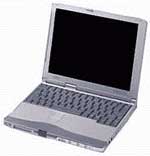 |
In a wide range of laptops manufactured by a consortium of Fujitsu Siemens, subnotebooks designated letter "B". In the Russian market today, there are two such models: In-2154 and B-2131, are not very expensive, but well-balanced decisions based on the Celeron 450 and 400, respectively. An interesting feature that distinguishes them from a long line of similar devices, is the organization of management of objects on the screen - along with the usual type anipulyatorom QuickPoint, located between the keys on the keyboard, use the pen input directly on the touch screen using a special staylusa included with a subnotebook. Special tools, offers maximum pen input, are supplied. In the standard addition is a port replicator (incidentally, both models have interchangeable) and external disk drive 3.5 "external the same 24x CDROM is optional. Subnotebook ThinkPad 240 is produced by IBM for quite a long time, indicating a large reserve capacity, which was originally inherent in this model. Not the last role was the fact that the developers subnotebook, not chasing ultra-slim size, have created a model is only slightly smaller than the usual notebook, but the keyboard size was maintained at 95% of the standard, which makes working with ThinkPad 240 special comfort. In addition, the most commonly used ports are built directly into the laptop itself, so there is no need to wear to an external port replicator, which is required for most other subnotebooks. Older versions ThinkPad 240, equipped with a processor Pentium IIISS 500, have 6-cell lithium battery that provides up to 4 hours of continuous operation, while their younger "brothers" that use processors Celeron 300-450, to reduce weight and, most importantly, value, work with a 3-cell battery, and the period of continuous operation at They are only 2 hours, but, nevertheless, and this value is quite acceptable.
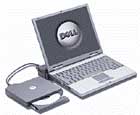 |
The most recent development firm in the class of subnotebooks Dell - Model L400, which is a powerful workstation (Pentium III processor 700 MHz with support for SpeedStep, in the standard package - 6 Gb HDD, 128 Mb RAM, preloaded with Windows 2000) with a weight of slightly more than 1, 5 kg and a thickness of 2.5 cm to increase the amount of memory, there is one slot on the motherboard where you can install the module size of 64, 128 or 256 Mb. Comes with an external 3,5 "FDD, but optional, you can use an external drive: 24X CD-ROM or CD R / RW, 8X DVD-ROM, Zip 250. 12.1-inch LCD monitor supports a resolution of 1024 x 768 at 24 -bit color.Following the latest trends in computer mode, subnotebook L400 has an "on board" not only an integrated modem and network card, which guarantees the owner of interaction with the outside world without any problems.
 |
As the most light and thin in the prestigious series Armada, subnotebook M300 is deservedly proud of the company Compaq. Reliability and durability of the computer in difficult road conditions, provides a rugged housing made of light magnesium alloys. To expand the scope of this subnotebook is possible to use the console Mobile Expansion Unit (MEU), which is simply tacked on to the Armada M300. The console comes with a 24X CD-drive or 8X DVD in the multipurpose bay Multibay (which is the standard for other series Armada). In this compartment can also set the drive SuperDisk LS-120, an extra lithium ion battery, second hard disk capacity of 6.4 GB or simply insert the plug. Console MEU serves as a port replicator and provides the system a set of additional tools, including parallel and serial ports, audio input / output ports VGA, USB, PS / 2 (2), plug the external power source and even a PremierSound, providing enhanced stereo sound Audio M300. Communication capabilities provide integrated 56 Kbps modem, although there are modifications and with a combined device that performs functions such as modem and network adapter 10/100 Ethernet. Thus, we consider several models of modern sub-notebooks, it can be concluded that, despite their more than modest size and weight, all of them on their possibilities in no way inferior to its much bigger brethren. A model of the Libretto or FIVA, with dimensions comparable to a sheet of paper A5, already with good reason be called the ultra-notebook. However, they are having a cost comparable to other models of sub-notebooks (especially the FIVA), significantly inferior to them in the comfort of work, mainly due to the reduced size of the keyboard - this is the price for such a small size.
Brief specifications considered subnotebooks
| manufacturer | model | Display | Video | processor | RAM capacity Articles / max., Mb | capacity HDD, Gb | slots are enlarged. | ports are enlarged. |
| Cassio | Cassiopeia Fiva MPC101 | 6,7 "TFT 800x600 | 64k col. | Media GX 200 MHz | 32/96 | 3,2 | 1 - PC-card II | IrDA, USB, PR |
| Cassio | Cassiopeia Fiva MPC102M63E | 6,7 "TFT 800x600 | 64k col. | Media GX 233 MHz | 64/96 | 6 | 1 - PC-card II | IrDA, USB, PR |
| Compaq | Armada M300 | 12,1 "TFT 1024x768 | 2 Mb | Pentium III 500/600 MHz | 64/320 | 6 / 12 | 1 - PC-card II | IrDA, USB, SVGA, PR |
| Dell | Latitude L400 | 12,1 "TFT 1024x768 | 4 Mb ATI Rage Mobility M | 700 MHz Pentium IIISS | 64/256 | 6/10/20 | 1 - PC-card II | LPT, IrDA, USB, PS / 2, SVGA, PR |
| Fujitsu | B2131 | 10,4 "TFT 800x600 | 2,5 Mb Trident | Celeron 400 MHz | 64/192 | 6 | 2-PC-card II or 1-PC-card III | IrDA, 2 USB, SVGA, PR |
| Fujitsu | B2154 | 10,4 "TFT 800x600 | 2,5 Mb Trident | Celeron 450 MHz | 64/192 | 6 | 1 - PC-card II | IrDA, 2 USB, SVGA, PR |
| IBM | ThinkPad 240 61G | 10,4 "TFT 800x600 | 2 Mb NeoMagic 2160 | Pentium III 500 MHz | 64/192 | 12 | 1 - PC-card II | COM, LPT, IrDA, USB, PS / 2, SVGA, PR |
| IBM | ThinkPad 240 41G | 10,4 "TFT 800x600 | 2 Mb NeoMagic 2160 | Celeron 400 MHz | 64/192 | 12 | 1 - PC-card II | COM, LPT, IrDA, USB, PS / 2, SVGA, PR |
| RoverBook | Voyager MT4 | 12,1 "TFT 1024x768 | 8 Mb ATI Rage Mobility M | 650 MHz Pentium IIISS | 64/192 | 6 / 12 | 1 - PC-card II | 4 USB, IrDA, SVGA, IEEE 1394 |
| Sony | PCG-C1XS | 8.9 "TFT 1024 x 480 | 2,5 Mb NeoMagic 256AV | Pentium II 400 MHz | 64/128 | 12 | 1 - PC-card II | USB, IrDA, SVGA, IEEE 1394 |
| Sony | PCG-C1VN | 8.9 "TFT 1024 x 480 | 8 Mb ATI Rage Mobility M | Crusoe TM5600 600 MHz | 128/192 | 12 | 1 - PC-card II, Memory Stick | USB, SVGA, IEEE 1394 |
| Sony | PCG-SR-5K | 10.4 "TFT | 3 Mb NeoMagic 256AV | Pentium III 500 MHz | 64/256 | 9 | 1 - PC-card II, Memory Stick | USB, SVGA, IEEE 1394 |
| Sony | PCG-SR-7K | 10.4 "TFT | 6 Mb NeoMagic 256XL | 600 MHz Pentium IIISS | 128/256 | 12 | 1 - PC-card II, Memory Stick | USB, SVGA, IEEE 1394 |
| Sony | PCG-SR-17K | 10.4 "TFT | 8 Mb S3 Savage IX | 700 MHz Pentium IIISS | 128/256 | 20 | 1 - PC-card II, Memory Stick | USB, SVGA, IEEE 1394 |
| Toshiba | Libretto 100 | 7,1 "TFT 800x480 | 2 Mb NeoMagic 2160 | Pentium 166 MHz | 32/64 | 2,2 | 2-PC-card II | IrDA, PR |
| Toshiba | Libretto 110 | 7,1 "TFT 800x480 | 2 Mb NeoMagic 2160 | Pentium 233 MHz | 32/64 | 4,1 | 2-PC-card II | IrDA, PR |
| Toshiba | Portege 3440 | 11,3 "TFT 1024x768 | 8 Mb S3 Savage IX | Pentium III 500 MHz | 64/192 | 6 | 2-PC-card II or 1-PC-card III | USB, IrDA, PR |
| Toshiba | Portege 3480 | 11,3 "TFT 1024x768 | 8 Mb S3 Savage IX | Pentium III 600 MHz | 64/192 | 12,1 | 2-PC-card II or 1-PC-card III | USB, IrDA, PR |
| manufacturer | model | communication | manipulator | food | Time is continuous.work, h | Dimensions, mm | weight, g |
| Cassio | Cassiopeia Fiva MPC101 | - | Thumb-pad | Li-ion, net | 3 | 210x132x25 | 850 |
| Cassio | Cassiopeia Fiva MPC102M63E | Modem V 90 | Thumb-pad | Li-ion, net | 3 | 210x132x25 | 850 |
| Compaq | Armada M300 | Modem V 90 | Touch-pad | Li-ion, net | 2 | 264x229x23 | 1480 |
| Dell | Latitude L400 | Modem V 90 10/100 Ethernet | Touch-pad | Li-ion, net | 4 | 272x220x25 | 1540 |
| Fujitsu | B2131 | Modem V 90 10/100 Ethernet | QuickPoint | Li-ion, net | 3 | 229h178h30 | 1360 |
| Fujitsu | B2154 | Modem V 90 10/100 Ethernet | QuickPoint | Li-ion, net | 3 | 250h199h30 | 1400 |
| IBM | ThinkPad 240 61G | Modem V 90 | Track-point | Li-ion, net | 4 | 259x203x27 | 1500 |
| IBM | ThinkPad 240 41G | Modem V 90 | Track-point | Li-ion, net | 2 | 259x203x27 | 1400 |
| RoverBook | Voyager MT4 | Modem V 90 10/100 Ethernet | Touch-pad | Li-ion, net | 1,5 | 269h218h25 | 1580 |
| Sony | PCG-C1XS | Modem V 90 | Stick-point | Li-ion, net | 2 | 249x152x29 | 998 |
| Sony | PCG-C1VN | Modem V 90 | Stick-point | Li-ion, net | 2,5 | 249x152x29 | 970 |
| Sony | PCG-SR-5K | Modem V 90 | Touch-pad | Li-ion, net | 3 | 259x208x25 | 1350 |
| Sony | PCG-SR-7K | Modem V 90 | Touch-pad | Li-ion, net | 3,5 | 259x208x25 | 1350 |
| Sony | PCG-SR-17K | Modem V 90 | Touch-pad | Li-ion, net | 3,5 | 259x208x25 | 1350 |
| Toshiba | Libretto 100 | - | AccuPoint | Li-ion, net | 3 | 210x132x35 | 910 |
| Toshiba | Libretto 110 | - | AccuPoint | Li-ion, net | 3 | 210x132x35 | 1060 |
| Toshiba | Portege 3440 | Modem V 90 | AccuPoint | Li-ion, net | 3 | 262x231x20 | 1550 |
| Toshiba | Portege 3480 | Modem V 90 | AccuPoint | Li-ion, net | 3 | 262x231x20 | 1550 |
Sources, Materials:








